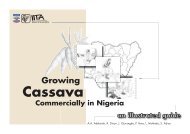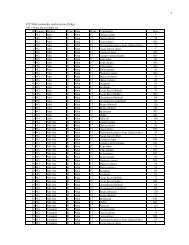Growing Pawpaw in Nigeria Growing Pawpaw - Cassavabiz.org
Growing Pawpaw in Nigeria Growing Pawpaw - Cassavabiz.org
Growing Pawpaw in Nigeria Growing Pawpaw - Cassavabiz.org
You also want an ePaper? Increase the reach of your titles
YUMPU automatically turns print PDFs into web optimized ePapers that Google loves.
COMMERCIAL CROP PRODUCTION GUIDE SERIES<br />
<strong>Grow<strong>in</strong>g</strong> <strong>Pawpaw</strong><br />
<strong>in</strong> <strong>Nigeria</strong><br />
United States Agency for<br />
International Development<br />
www.usaid.gov<br />
Information and Communication<br />
Support for Agricultural<br />
Growth <strong>in</strong> <strong>Nigeria</strong><br />
www.ics-nigeria.<strong>org</strong><br />
ICS-<strong>Nigeria</strong>
<strong>Grow<strong>in</strong>g</strong> <strong>Pawpaw</strong> <strong>in</strong> <strong>Nigeria</strong><br />
Variety<br />
Various accessions of land races and exotic varieties such as Homestead,<br />
P<strong>in</strong>k solo, Kapoho solo and JS.22 are available at the National Horticultural<br />
Research Institute (NIHORT). S<strong>in</strong>ce fruit size, shape, pulp color, and time of<br />
fruit<strong>in</strong>g differ, advice must be sought <strong>in</strong> select<strong>in</strong>g which variety to plant.<br />
Nursery<br />
Although pawpaw may be planted directly <strong>in</strong> the orchard, considerable<br />
sav<strong>in</strong>gs can be made on seeds and labor, by us<strong>in</strong>g transplanted seedl<strong>in</strong>gs<br />
raised <strong>in</strong> the nursery. Raise seedl<strong>in</strong>g from seeds extracted from ripe pawpaw<br />
fruits. Scrub the seeds lightly with sand to remove the gelat<strong>in</strong>ous cover<strong>in</strong>g. Mix<br />
the slurry of sand with water; the bad seeds and gelat<strong>in</strong>ous cover<strong>in</strong>g of the<br />
seed will float. These should be removed. Dra<strong>in</strong> the good seeds and spread<br />
out <strong>in</strong> the shade to air dry. Sow the air-dried seed trays, polybags or any cont-<br />
-a<strong>in</strong>er which has rich moist topsoil by water<strong>in</strong>g every other day. The seeds<br />
should germ<strong>in</strong>ate with<strong>in</strong> 2 weeks and be ready for transplant<strong>in</strong>g with<strong>in</strong> 8–12<br />
weeks after sow<strong>in</strong>g. Seeds meant for transplant<strong>in</strong>g <strong>in</strong> May should be sown <strong>in</strong><br />
February/March.<br />
Orchard management<br />
Site the orchard on a well-dra<strong>in</strong>ed soil. Although loamy sand is preferred,<br />
pawpaw can tolerate a wide range of soils provided it is not waterlogged.<br />
Plough and harrow the orchard site and plant the seedl<strong>in</strong>gs <strong>in</strong> holes of 15 cm<br />
—20 cm deep and 2 x 2 m spac<strong>in</strong>g. In large plant<strong>in</strong>g areas, after plant<strong>in</strong>g<br />
10 rows, leave a corridor of 4 m to allow movement of equipment. Plant 3<br />
or 4 seedl<strong>in</strong>gs per hole when us<strong>in</strong>g a dioecious variety, to ensure a high<br />
female population. Transplant the seedl<strong>in</strong>gs when the ra<strong>in</strong>s have stabilized.<br />
Homestead plants set fruit 3 months after transplant<strong>in</strong>g and ripen<strong>in</strong>g starts 8<br />
months after transplant<strong>in</strong>g and lasts 3 months. Harvest fruit at “Blush” stage<br />
and avoid bruis<strong>in</strong>g. About 40—70 t/ha can be obta<strong>in</strong>ed s<strong>in</strong>ce yield decl<strong>in</strong>es<br />
after second harvest. Plants should be cut down after 3 years, a break crop<br />
can be planted before the old trees are cut down on the same site and used<br />
aga<strong>in</strong>. Establish another orchard 2 years after the bear<strong>in</strong>g orchard to ensure<br />
a cont<strong>in</strong>uous fruit supply.<br />
Fertilizer application<br />
Apply 50 g of NKP 15-15-15 per plant , 3 weeks after transplant<strong>in</strong>g and at<br />
monthly <strong>in</strong>tervals up to 6 months after transplant<strong>in</strong>g. Optimum yields have been<br />
obta<strong>in</strong>ed us<strong>in</strong>g 45 g N/plant and a 1:2 N: P ratio. However, application rates<br />
should be based on soil test results <strong>in</strong> order to make maximum use of the fertilizer application.<br />
1
Weed<strong>in</strong>g<br />
Weed contol is very important especially dur<strong>in</strong>g the first 3 months after<br />
transplant<strong>in</strong>g. This may be achieved by hoe weed<strong>in</strong>g, slash<strong>in</strong>g at monthly<br />
<strong>in</strong>tervals , or by the use of the herbicide Paraquat glyphosate at 4—6 or 3 kg<br />
active <strong>in</strong>gredient per hectare.<br />
Irrigation<br />
Dry season irrigation is important for pawpaw. For newly transplanted<br />
seedl<strong>in</strong>gs, apply 3 liters of water per plant twice a week, For flower<strong>in</strong>g plants,<br />
apply 5 litres twice a week, and for bear<strong>in</strong>g plants apply 15 liters of water per<br />
plant once a week.<br />
Intercropp<strong>in</strong>g<br />
Intercrop pawpaw, planted at a spac<strong>in</strong>g of 2 x 2 m, with early matur<strong>in</strong>g plants<br />
like okra, leafy vegetable, melon, sweet potato, or sweet corn. These plants<br />
should mature with<strong>in</strong> 3 months or poor yields will be obta<strong>in</strong>ed due to shad<strong>in</strong>g<br />
of pawpaw canopies.<br />
Pest control<br />
Nematode control is very important. This can be achieved by apply<strong>in</strong>g a<br />
teaspoonful of Furadan per seedl<strong>in</strong>g, 3 weeks after transplant<strong>in</strong>g and rotat<strong>in</strong>g<br />
the orchard. If grasshoppers <strong>in</strong>vade the plot spray Gamal<strong>in</strong> 20 15 mls/10<br />
liters of water.<br />
Summary;<br />
1. Use recommended variety<br />
2. Use recommended spac<strong>in</strong>g<br />
3 Apply fertilizer as recommended<br />
4 Irrigate <strong>in</strong> the dry season<br />
5 Harvest at ‘Blush’ stage<br />
The <strong>in</strong>formation for this Production Guide was obta<strong>in</strong>ed from Extension Research Liaison and<br />
Tra<strong>in</strong><strong>in</strong>g Unit<br />
National Horticultural Research Institute (NIHORT)<br />
PMB 5432,<br />
Idi ish<strong>in</strong>, Ibadan.<br />
2
About ICS-<strong>Nigeria</strong><br />
Information and Communication Support for Agricultural Growth <strong>in</strong><br />
<strong>Nigeria</strong> (ICS-<strong>Nigeria</strong>) is a project which aims to <strong>in</strong>crease the quantity and quality<br />
of <strong>in</strong>formation available for <strong>in</strong>creased agricultural production, process<strong>in</strong>g, and<br />
market<strong>in</strong>g and also strengthen the capacity of farmer assistance <strong>org</strong>anizations<br />
to package and dissem<strong>in</strong>ate <strong>in</strong>formation and agricultural technologies to farmers<br />
for the alleviation of rural poverty.<br />
In the recent past, <strong>in</strong>vestment <strong>in</strong> the support services to <strong>Nigeria</strong>n agriculture has<br />
been neglected with the result that this sector has not realized its full potential<br />
to contribute to the prosperity and economic development of the country. Meanwhile,<br />
<strong>in</strong>creas<strong>in</strong>g population pressure and the accompany<strong>in</strong>g need to <strong>in</strong>tensify<br />
agricultural production is lead<strong>in</strong>g to erosion of the natural resource base on<br />
which agriculture depends.<br />
The susta<strong>in</strong>ability of production is threatened by a vicious cycle of decl<strong>in</strong><strong>in</strong>g soil<br />
fertility and <strong>in</strong>creas<strong>in</strong>g problems of pests, diseases, and weeds. Moreover, the<br />
lack of knowledge on how to add value through proper storage, process<strong>in</strong>g, and<br />
market<strong>in</strong>g impedes agricultural growth.<br />
Promis<strong>in</strong>g technologies exist to address these problems, but their adoption<br />
is constra<strong>in</strong>ed by a lack of <strong>in</strong>formation packaged <strong>in</strong> appropriate formats, and<br />
poor communication channels for this <strong>in</strong>formation, between farmers and the research,<br />
extension, and education <strong>org</strong>anizations that are supposed to address<br />
these issues.<br />
ICS-<strong>Nigeria</strong> aims to assist <strong>in</strong> meet<strong>in</strong>g these challenges by develop<strong>in</strong>g appropriate<br />
format materials for dissem<strong>in</strong>at<strong>in</strong>g <strong>in</strong>formation and agricultural technologies<br />
to target user groups, while <strong>in</strong>creas<strong>in</strong>g capacity of farmer assistance <strong>org</strong>anizations<br />
to produce <strong>in</strong>formation materials. At the same time, communication channels<br />
will be re<strong>in</strong>forced so that <strong>in</strong>formation fl ow is enhanced.<br />
Agricultural technologies have been selected on the basis that they will lead to<br />
agricultural commercialization thereby enhanc<strong>in</strong>g rapid <strong>in</strong>come generation for<br />
farmers and private sector practitioners. The project is tak<strong>in</strong>g advantage of exist<strong>in</strong>g<br />
agricultural development programs <strong>in</strong> <strong>Nigeria</strong>, national research <strong>in</strong>stitutes,<br />
and <strong>in</strong>ternational research <strong>in</strong>stitutes <strong>in</strong> and out of <strong>Nigeria</strong> to identify these technologies.<br />
The project is also tak<strong>in</strong>g advantage of exist<strong>in</strong>g successful partnerships<br />
aris<strong>in</strong>g from recent and ongo<strong>in</strong>g programs to enhance <strong>in</strong>formation fl ow.<br />
ICS-<strong>Nigeria</strong> is funded by USAID.<br />
International Institute<br />
of Tropical Agriculture<br />
www.iita.<strong>org</strong>















